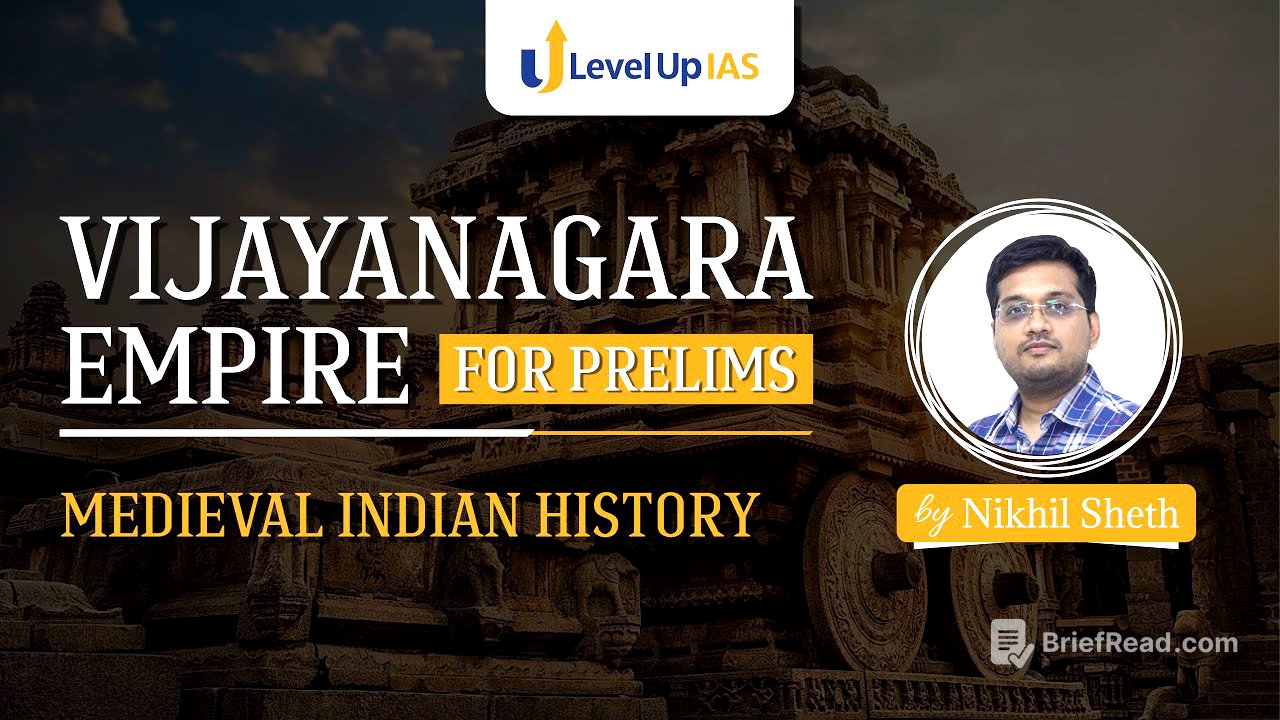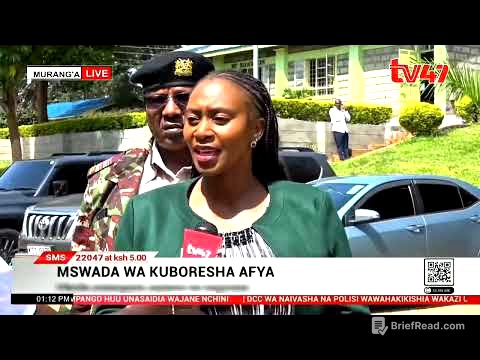TLDR;
This video provides a detailed overview of the Vijayanagara Empire, covering its history, rulers, administration, economy, society, and cultural contributions. It emphasizes the empire's significance, its context within the broader history of South India, and its interactions with other powers like the Bahmani Sultanate. The lecture also highlights the importance of understanding Vijayanagara's cultural contributions and its unique administrative and economic systems.
- The Vijayanagara Empire lasted for over 200 years and had a significant cultural impact.
- The empire emerged in the context of the decline of the Delhi Sultanate's expansion in South India.
- Key rulers include Harihara, Bukka, Devaraya I and II, and Krishnadevaraya.
- The empire's administration involved a complex system of central and provincial governance, with unique features like the Nayankara and Ayagara systems.
- Vijayanagara society was caste-based but also exhibited some degree of social mobility and patronage of diverse talents.
Introduction [0:00]
The lecture introduces the Vijayanagara Empire, noting its establishment in the 1330s and its duration of over 200 years. It highlights that while the core Vijayanagara period lasted for about 220 years, its influence lingered for almost a century afterward. The discussion will focus on the first and third dynasties, which are considered the most important, while briefly touching upon the second and fourth dynasties. The empire's significant cultural contributions and long duration make it a crucial topic for study.
Historiography of Vijayanagara [10:00]
The chapter discusses the historiography of the Vijayanagara Empire, noting that initial awareness in the modern world came through English botanist Hamilton, who surveyed South India and encountered the empire's remains. Mackenzie further collected data and manuscripts, while Mark Wilkes, a British resident in Mysore, also gathered information. Robert Sewell's book, "The Forgotten Empire," focused on Portuguese sources, particularly the travelogues of Domingo Paes and Fernão Nunes, who provided glowing accounts of Krishnadevaraya's reign. Later, Indian historians like Nilakanta Sastri expanded beyond Portuguese sources, incorporating inscriptions and Telugu poems to enrich the historical narrative.
Harihara and Bukka [13:24]
The chapter focuses on Harihara and Bukka, the founders of the Vijayanagara Empire. They were initially officers of either Warangal or Dwarasamudra, both of which were destroyed by Muhammad bin Tughlaq (MBT). In 1326, MBT's armies overran the Deccan, and Harihara and Bukka were arrested, converted to Islam, and appointed to rule Kampili as representatives of the Delhi Sultanate. According to legend, they were reconverted to Hinduism by Vidyaranya Swami of Sringeri. They jointly ruled, assuming titles like "Hindu Raya Suratrana," a hypercorrection blending Hindu and Muslim terms. Harihara expanded the empire, facing conflicts with the Madurai Sultanate. By 1346, the five Sangama brothers gathered in Sringeri to celebrate Harihara's dominance, marking the formal establishment of Vijayanagara with Virupaksha as the principal deity. Bukka, Harihara's brother, continued the expansion, with his son Kumara Kampana leading the campaign against Madurai, restoring worship at the Srirangam temple.
Devaraya I and II [31:46]
The chapter discusses Devaraya I, who faced Firoz Shah Bahmani and had to cede territory and marry his daughter to him. Devaraya I modernized his army by employing skilled archers of Turkish clan and improving his cavalry with horses from Arabia and Persia. He even built a mosque in Hampi for the convenience of his Muslim soldiers. Later, in alliance with Warangal, Devaraya I defeated the Bahamanis. The Italian traveler Niccolò de' Conti visited during his reign, describing Vijayanagara as a well-provisioned city as large and beautiful as Rome, and noted the prevalence of Sati. Abdul Razzaq, an ambassador from Persia, visited during Devaraya II's reign, describing the wealth and splendor of the capital and its markets. Devaraya II himself was a poet and patron of literature. Kannada poets like Chamarasa and Jakkanarya were prominent during his rule. Madhavacharya wrote important works like "Sarvadarshana Sangraha," "Sankara Digvijaya," and "Sangeeta Sara." Sayana, considered Madhavacharya's brother, wrote commentaries on the Vedas.
Krishnadevaraya [48:34]
Krishnadevaraya, the most famous king of the Tuluva Dynasty, oversaw what is considered the second golden age of the Vijayanagara Empire. He led the Battle of Raichur in 1520, gaining control over the Raichur Doab. He took the title "Yavana Rajya Sthapanacharya," meaning he re-established the Yavana (Muslim) kingdom. Krishnadevaraya's astute diplomacy with the Portuguese allowed him to secure a monopoly on horse imports, strengthening his military. He was not only a great conqueror but also a great author, writing "Amuktamalyada" in Telugu and "Jambavati Kalyanam" in Sanskrit. His court was adorned with eight accomplished scholars known as "Ashtadiggajas," including Allasani Peddana and Nandi Thimmana. Domingo Paes provided a detailed physical description of Krishnadevaraya, noting his medium height, fair complexion, and signs of smallpox. Krishnadevaraya established new cities like Nagalapura and expanded irrigation projects.
Achyuta Raya [1:09:05]
Achyuta Raya, Krishnadevaraya's half-brother, came to power after Krishnadevaraya's death. During his reign, the Portuguese traveler Fernão Nunes visited India and provided details about Krishnadevaraya, although he never personally met him. Nunes described women scribes, wrestlers, astronomers, musicians, and fortune-tellers, highlighting women's diverse roles in society. Cultural achievements of Achyuta Raya's era include the Vitthala Temple at Hampi and the Lepakshi Temple, built by his governors Virupanna and Viranna.
Aliya Rama Raya and Talikota [1:13:37]
Aliya Rama Raya, Krishnadevaraya's son-in-law, never crowned himself king but was the real power behind the throne. His policies led to the Battle of Talikota in 1565, where the combined armies of the three Deccan Sultanates defeated Vijayanagara. Rama Raya's strategy of playing the Sultanates against each other backfired when they united against him. The Vijayanagara army was relatively backward, and the defection of Muslim generals in Rama Raya's army contributed to the defeat. The city of Vijayanagara was destroyed, becoming a ghost town.
Aravidu Dynasty [1:19:00]
After the Battle of Talikota, the Aravidu Dynasty attempted to re-establish the capital, but the city was eventually abandoned. The capital shifted to Penukonda and later to Chandragiri. The empire's power was diminished, and different Nayakas emerged, marking the end of the Vijayanagara Empire's prominence.
Administration, Taxation, Economy, Society [1:21:12]
The chapter discusses the administration, taxation, economy, and society of the Vijayanagara Empire. The empire was theoretically an absolute monarchy, but historians debate the extent of centralization. The king ruled in the name of Lord Virupaksha, following a tradition started by the Ganga dynasty of Odisha. The central administration included the Mantri Parishad (cabinet) and Sachivalaya (secretariat). The empire was divided into provinces governed by Rajyapalas. The Ayagara system replaced the local self-government of the Chola era, with village officials appointed by the state. The Nayankara system was similar to the Iqtadari system, with military officials paid in land grants. Land revenue was the most important source of revenue, varying based on soil quality, crop type, and the caste of the peasants. Irrigation was crucial, with efforts to expand it and taxes levied on water usage. Temples played a significant economic role, acting as landholders, bankers, and investors. Society was caste-based, with Brahmins holding the highest position. The condition of women was mixed, with practices like child marriage and Sati, but also instances of social reform and women's involvement in various fields.









